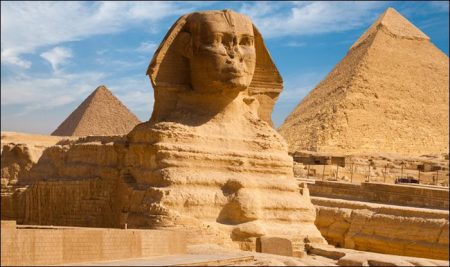5000 BC First evidence of people settling along the Nile Delta
4400 – 4000 BC Babarian culture- people practiced agriculture and domesticated sheep and goats, — known for pottery
4000 – 3500 BC Amratian Society of Upper Egypt – first signs of hierarchical civilization
3200 BC Hieroglyphics developed
3110 – 2884 BC Menes joined Upper and Lower Egypt into one kingdom with the capitol at Memphis
3000 BC Irrigation increased farmland, people worship the sun
3000 – 2890 BC 1st Dynasty kings buried in first royal tombs at Abydos
1st Dynasty
(2920 – 2770) During this time the capital at Memphis was founded. Papyrus was invented. Writing was used by the government. Many impressive artifacts have been found from this period.
2890 – 2686 BC Wooden coffins and corpses wrapped in resin
2nd Dynasty
(2770 – 2650) After much rivalry for the throne Hetepsekhemsy won. At this time the kings disagreed over which god, Horus and Seth, was in power. This was finally settled when Khasekhemwy became ruler. He took both titles. Disorder erupted during the end of this dynasty. There could have been a civil war.
3rd Dynasty
2686 – 2648 BC Step Pyramid at Saqqara built by King Djoser
4th Dynasty
(2575-2467) During this dynasty there was a great peace. The kings were able to put their energies in art. King Khufu’s Great Pyramid of Giza was built. People prayed to the sun god Re. The first religious words were written on the walls of the royal tombs.
2550 – 2490 BC Khufu (Cheops), Khephren (Chephren), and Menkare build great pyramids
2494 – 2487 BC King Userkaf builds temple for sun god Ra at Abusir.
5th Dynasty
(2465-2323)
For the first time high officials came from people outside of the royal family. The pyramids begin to be smaller and less solid. However, the carvings in the temples were of great quality. Papyrus scrolls from this time have been discovered. They showed record keeping of goods.
2375 – 2345 BC The Pyramid Texts describe Osiris
2420 – 2258 BC Pepi I and Pepi II rule – government weakens
6th Dynasty
(2323-2152) Many records of trading expeditions have been discovered from this period.
2160 BC Capitol moves from Memphis to Herakleopolis in northern Middle Egypt – Upper Egypt controlled by Theban rulers.
7th and 8th Dynasties
(2150 – 2135) The political structure of the Old Kingdom collapsed. There was famine, civil disorder, and a high death rate.
9th and 10th Dynasties
(2135 – 1986) Egypt split into the north, ruled from Herakleopolis, and the south, ruled from Thebes.
11th Dynasty
(2074-1937) Prosperous period with much foreign trade. Many large building projects. Skilled jewelry making.
The government became strong with King Amenemhet I’s rule.
Egypt was unified once again under the rule of Metuhotep. He built an exceptional mortuary complex at Dyr al-Bahri.
2134 – 2000 BC Capital moved to Thebes – Egypt is reunited by Mentuhotep II
1985 – 1956 BC Amenemhat I begins trade with Asia and the Aegean
1956 – 1911 BC Collection of letters from a farmer to his family written describing family and agricultural life
1956 – 1911 BC Senusret I builds temple of Karnak at Thebes
12th Dynasty
(1937-1756)
Amenemhet moved the capital back to Memphis. Sesostris II reorganized Egypt into 4 regions (northern and southern halves of the Nile Valley and eastern and western Delta).
1877 – 1870 BC Senusret II builds Faiyum irrigation scheme
13th, 14th, 15th, 16th, & 17th Dynasties
(1783-1539) Few monuments from this period survived. Each king reigned for only a short time. Some of these kings were born commoners. The eastern Delta region broke away during this time.
1700 BC Earliest evidence of diagnostic medicine
1650 BC Capital moved to Thebes – Extensive building
1650 – 1580 BC spells known as the Book of the Dead first appear
1560 BC War between Thebes and Asiatic ruler
18th Dynasty
(1539-1295) Ahmose finally beat the Hyksos and sent them out of Egypt. This dynasty had a number of strong rulers.
Thutmose I conquered parts of the Near East and Africa.
Hatshepsut and Thutmose made Egypt a super power.
Amenhotep II began an artistic revolution.
Akhenaton and Nefertiti began a new religion with one god.
Tutankhamen reigned.
1532 – 1528 BC Asiatic kings conquer capital of Hyksos
1504 – 1492 BC Thutmose I begins military campaigns
1380 BC Building of the Temple of Luxor by Amenhotep III
1367 – 1350 BC Rule of Amenhotep IV (Akhenaton) – changed from a polytheism to a monotheistic society
1336 – 1327 BC Reign of Tutankhamon
19th Dynasty
(1295-1186) Seti I restored many monuments. His temple at Abydos has some of the most superior carved wall relief. Many battles and treaties were written between Egypt and Asiatic powers.
1279 – 1213 BC Ramses II begins building projects – including his mortuary temple The Ramesseum (on the West Bank near Luxor)
20th Dynasty
(1186-1069) Setakht restored order to the country. Ramesses III was one of the greatest kings.
1186 – 1089 BC Royal Tombs in the Valley of the Kings plundered
21st Dynasty
(1070-945) The kings weakened, and Egypt was no longer a world power.
Civil war and foreign invaders tore Egypt apart.
The capital moved from Tanis to Libyan, to Nubia, to Thebes, to Sais, and then back to Nubia and Thebes.
1069 BC Civil War
1069 – 1043 BC Mummification techniques improved
984 BC Osorkon the Elder becomes the first Libyan pharaoh
22nd Dynasty (945-712)
23rd Dynasty
(828-725)
730 BC Conquest of Egypt by Kush under Kashta and then Piankhy
24th Dynasty (725-715)
25th Dynasty
(712-657) The Nubians fell under the Assyrians invasion.
The Greeks helped re-establish order.
A renaissance in the arts of the 25th Dynasty showed a return to the Old Kingdom style.
26th Dynasty (664-552
)Mid 650s BC Psamtek I drives off Assyrian invaders and defeats Kushite kings
610 – 595 BC Nekau Ii begins to construct a canal from Nile to the Red Sea
27th Dynasty
(525-404) The Persian Conquest
The Persians invaded and ruled Egypt. They were pushed out in 404 B. C.
525 BC Persians invade Egypt, Cambyses defeats the Egyptians at the Battle of Pelosium
510 – 497 BC King Dauius completes the canal from the Nile to the Red Sea
28th Dynasty
(404 -399) Amytravios retakes Egypt from Persia
29th Dynasty (399-380)
30th Dynasty
343 – 342 BC Artaxerxes I of Persia retakes Egypt
332 BC Alexander the Great invades Egypt
331 BC Alexandria is founded
323-30 BC Ptolemaic Dynasty
Confusing time with many co-regencies.
Alexandria became the new capital. It was home to the greatest library of the ancient world.
Egypt was powerful until Cleopatra died. Egypt was then ruled by Rome.
300 BC The Temple of Isis was built on the island of Philae in the Nile River.
31 BC Queen Cleopatra VII and Mark Anthony are defeated – Octavian enters Egypt beginning Roman rule
Roman Emperors
After Cleopatra and Antony committed suicide in 30 B. C. Egypt was ruled by the Romans.
Egypt does not have another Egyptian ruler for 2000 years.
395 – 641 AD Egyptian hieroglyphic writing is no longer used – People can no longer understands its symbols
641 AD Egypt conquered by Muslin Arabs
1822 AD Rosetta Stone helps Jean Francois Chompollion break the hieroglyphic code.
Visits: 90



